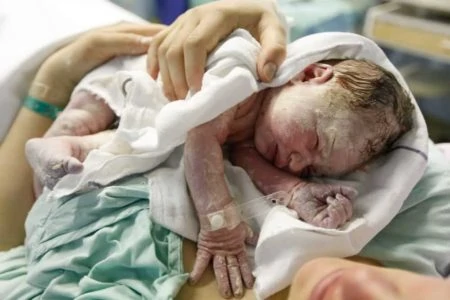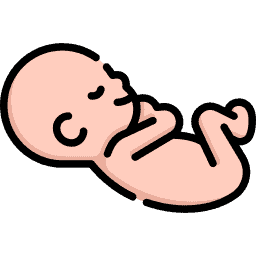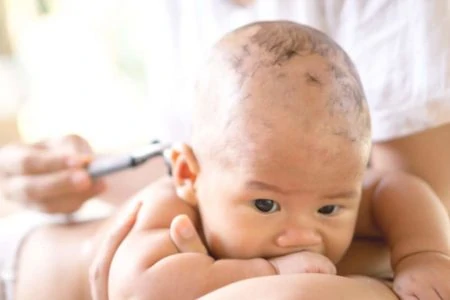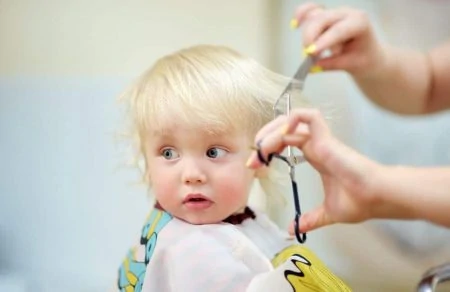It can be surprising to see your newborn covered in a thin layer of body hair, but don’t panic. This hair is called lanugo, and it is totally normal, especially for babies born a bit early.
In this article, we will explain exactly what lanugo is, why babies grow it, and when you can expect it to disappear.
Key Takeaways
- Lanugo is a soft, unpigmented hair that grows on fetuses to keep them warm and protect their skin in the womb.
- It plays a vital role in binding the vernix (a cheesy protective coating) to the skin, preventing damage from amniotic fluid.
- Most babies shed lanugo before birth or within a few weeks of life, though preemies often have more of it.
- A distinct patch of hair specifically located on the lower spine is different from lanugo and could indicate spina bifida.
What Is Lanugo?
Lanugo is a fine, downy, unpigmented hair that starts sprouting on babies around the fourth or fifth month of pregnancy (1).
Think of it as your baby’s first fur coat. It grows everywhere on their body, except for a few specific spots:
- Palms of the hands.
- Lips.
- Soles of the feet.
- Genitals.
- Nails.
This hair usually starts on the scalp and works its way down the face, covering the forehead, nose, and shoulders before reaching the feet.
If your baby arrives early, they are much more likely to be covered in lanugo. Full-term babies usually shed most of this hair while still inside the womb, typically around the eighth month of gestation.
So, where does that hair go? The baby sheds it into the amniotic fluid.
Here is a fun fact (or a gross one, depending on your stomach): your baby swallows that amniotic fluid, hair and all. This digested hair actually makes up a large part of meconium, that sticky, dark green tar-like poop you will find in their first few diapers.
Once lanugo falls out, it is replaced by two other hair types: vellus hair (the peach fuzz we all have) and terminal hair (the thick stuff on our heads and eyebrows).
What’s the Purpose of Lanugo?
It might look odd, but that hair is working hard. Inside the uterus, lanugo acts like a physical anchor for vernix.
Vernix is that white, cheese-like substance that coats newborn babies (read more about vernix here). Without lanugo to hold onto, the vernix would slide right off. Together, the hair and the vernix form a waterproof barrier that protects your baby’s delicate skin from becoming wrinkled, chapped, or hardened by constant exposure to amniotic fluid.
Lanugo also plays a role in temperature regulation:
- Insulation: Before your baby builds up enough body fat, this hair traps heat to keep them warm.
- Growth Stimulation: Some researchers believe the movement of lanugo hairs transmits vibrations to the baby’s sensory receptors, potentially stimulating growth (2).
How Long Does Lanugo Last?
Around 30% of full-term babies are born with some visible lanugo. It is often hard to see because it can be hidden under the vernix or is very light in color.
If your little one looks a bit hairy, relax. It generally falls out on its own within the first few weeks or months of life. Friction from clothes, bedding, and bathing helps rub it away naturally.
Please avoid the temptation to remove it yourself.
Do not shave, wax, or scrub your baby’s body hair. Newborn skin is incredibly sensitive, and trying to remove the hair can cause rashes, irritation, or pain. If the hair persists for several months and you are worried, chat with your pediatrician rather than taking matters into your own hands.
Can Lanugo Grow on Adults?
While lanugo is normal for babies, it is generally a warning sign in adults.
If an adult or older child starts growing fine, downy hair on their face, back, or arms, it is usually a symptom of severe malnutrition or an eating disorder like Anorexia Nervosa.
When the body is starving, it loses its protective fat stores. To compensate, the body attempts to insulate itself by growing a layer of lanugo to trap heat and prevent hypothermia. If you notice this on yourself or a loved one, it is critical to seek medical attention immediately.
When To Worry: A Patch of Hair Near the Spine
While generalized body hair is harmless, a specific patch of hair on the lower back can be a clue to something else.
If you spot a tuft of hair, a deep dimple, or a birthmark right over the spine, it could be a sign of **Spina Bifida Occulta**.
What Is Spina Bifida?
Spina bifida is a neural tube defect that happens when a baby’s spine does not close completely during the first month of pregnancy. This can damage the spinal cord and nerves.
There are different levels of severity:
- Myelomeningocele: The most severe form, where the spinal canal is open along several vertebrae. The spinal cord pushes out, forming a sack on the baby’s back.
- Meningocele: A sack of fluid comes through an opening in the back, but the spinal cord is not in this sack.
- Spina Bifida Occulta: The mildest and most common form. “Occulta” means hidden. There is a small gap in the spine, but no opening or sack on the back (3).
Signs of Spina Bifida Occulta
Because the defect is hidden under the skin, many people have this condition without ever knowing it. It usually does not cause disabilities.
However, the skin above the spinal defect often displays a marker:
- An abnormal tuft of hair.
- A dimple or pit.
- A red or purple birthmark (hemangioma).
- A fatty lump.
If you notice these signs on your newborn’s lower back, your doctor may order an ultrasound or X-ray just to check the spinal cord’s attachment.
Prevention and Causes
The exact cause is often a mix of genetics and environment, but folic acid plays a huge role in prevention.
Spina bifida occurs when the neural tube fails to close properly in the first 28 days of pregnancy. Low levels of folic acid (vitamin B9) increase this risk significantly. This is why doctors recommend taking prenatal vitamins with folic acid even before you start trying to conceive.
Other risk factors include:
- Family history of neural tube defects.
- Diabetes or obesity in the mother.
- High fevers during early pregnancy.
- Use of certain anti-seizure medications (4).
FAQs
In Conclusion
Seeing a fuzzy newborn might not be what you expected, but it is a sign that their body was doing exactly what it needed to do inside the womb.Whether your baby is bald or rocking a full coat of lanugo, remember that it is temporary. That soft fuzz will shed naturally, revealing the baby soft skin underneath. Enjoy the cuddles while it lasts!










